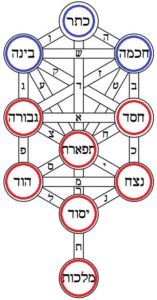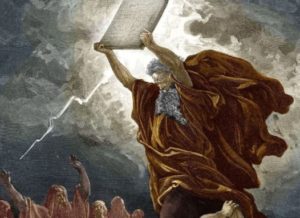In this week’s parasha, Vayera, the word “love” appears for the first time in the Torah. There is a general rule that when a certain term appears for the first time in the Torah, the context in which it appears can teach us the true meaning of that term. Nothing is coincidental, of course, so if a word makes its first appearance in a particular place, this is where to look in order to understand its significance. It is specifically when God puts Abraham to the test that the Torah tells us Abraham loved his son Isaac (Genesis 22:2). There is much we can learn from this. Continue reading
Tag Archives: Netzach and Hod
Practical Jewish Meditation
In this week’s parasha, Ki Tisa, we read how Moses goes up Mount Sinai on three separate occasions. His first ascent concludes with receiving the Two Tablets, only to come down and see the horror of the Golden Calf. Following this, the Torah tells us that “Moses returned to God”, back up the mountain, to address the Calf fiasco and its aftermath (Exodus 32:31). Moses then came back down to pitch a “Tent of Meeting” (33:7) where he could more regularly communicate with God without having to ascend the Mountain, and for when the Israelites would leave Sinai to head to Israel. Moses asked to see God’s Presence directly, and God replied that no mortal can see God and live, though He would show Moses His “back”. To do this, God asked Moses to come up Sinai one last time (34:2), where a new set of tablets would be created to replace the shattered ones.
When Moses descended from Sinai for the last time to present the new Tablets, the Torah tells us that “He was there with God for forty days and forty nights; he ate no bread and drank no water…” (34:28) Moses had gone up Sinai three times, each for forty days, making 120 days total. Indeed, if one counts the days of the Jewish calendar between Shavuot and Yom Kippur, one would find 120 days, since Shavuot is the date of the initial Sinai Revelation while Yom Kippur is when God forgave the Israelites for the Golden Calf and Moses returned with the new Tablets. At the end of Moses’ three sessions of intense meditation with God, his face glowed and the people could no longer look at him directly (34:29-30). Moses would henceforth wear a mask.
The Torah motif of going up a mountain to spend time in prayer and divine meditation spread all over the world, and we find very similar descriptions in other faiths that emerged after Judaism. Buddha, for instance, spent 40 days (or 49 days) up on a mountain meditating under a bodhi tree to attain enlightenment, and also abstained from food and water during that time. Jesus is said to have spent forty days in the wilderness without food and water, and Mohammad purportedly received his first revelation while meditating and fasting for days on Mount Hira at the age of 40. Despite the fact that Moses was undoubtedly the first, meditation today is associated more with Eastern faiths, and strangely not with Judaism.
The truth is that meditation has always been central to Judaism since ancient times. In fact, it is highly likely that it was Jewish exiles who introduced meditative practices around the world after their expulsion from Israel in the 6th century BCE at the hands of the Babylonians. It is intriguing to point out that many world religions began in the century following Israel’s exile, including Buddhism and Confucianism, as well as the Pythagorean and Orphic religions in Greece. Even ancient Zoroastrianism and Hinduism were heavily influenced by spreading Torah ideas in the middle of the first millennium BCE.
Today, science has uncovered the vast benefits of regular meditation—everything from reducing stress and improving sleep, to boosting the immune system and accelerating healing, even positively impacting the expression of our genes! So, what does the Torah tradition have to teach us about meditation, and what are some specific Jewish meditative techniques we can put into practice daily to enhance our lives? Continue reading
Ten Sefirot: A Brief History

The Sefirot of mochin above (in blue) and the Sefirot of the middot below (in red) on the mystical “Tree of Life”.
This week, in parashat Yitro, we read the Ten Commandments. As with all other things that are ten in the Torah, the Ten Commandments correspond neatly to the Ten Sefirot. Just as the first three of the Sefirot are on a higher plane, referred as the mochin, the first three of the Commandments are also distinct and relate directly to God (to know there is a God, to have no other gods or idols, and not to take God’s Name in vain). We saw a similar division of ten into groups of three and seven in the Ten Plagues, where the first seven are read in parashat Va’era, and the final three in parashat Bo. Likewise, we find a division of ten into three and seven in the very first case of ten: the Ten Utterances of Creation.
As our Sages famously teach, God created the entire universe through Ten Utterances (Avot 5:1). When we look in the first chapter of Genesis at the account of Creation, we find the expression “And God said” exactly 10 times. It was through these Ten Utterances that God brought the entire cosmos into existence. It is important to note that the last instance of “And God said” (1:29) is really just a continuation of the ninth instance (1:28). The actual remaining Utterance is the first word of the Torah: Beresheet. This word itself was the First Utterance, and was the initial burst of energy that brought a dark universe into existence. The Second Utterance was “Let there be light”, and the Third was “Let there be a firmament”. While the first three clearly involve grand cosmic developments, the remaining seven Utterances all relate specifically to Earth.
Of course, all of the above tens correspond to the Ten Sefirot, the first emanations that emerged out of God’s Infinite Ein Sof. The Ten Sefirot permeate all of existence, which is why we find so many patterns of ten in the Torah and all around us in Creation. The notion of Ten Sefirot is a foundational and inseparable part of Judaism, yet few are aware of where all the information about the Sefirot came from! It is commonly thought that the Sefirot were first revealed by the Zohar, but this is highly inaccurate. Discussion of the Sefirot dates back centuries before the first publication of the Zohar. So, let’s take a brief trip back in time to explore the historical revelation of the Sefirot. Continue reading

